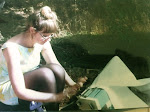A little while back I wrote the catalogue essay for Riley O'Keefe's Nothing Object, Forever.
Riley O’Keeffe
Nothing-Object, Forever
One
“From ultra-marine, beyond the sea, to ultra-sky, the horizon divides opacity from transparency. It is just one small step from earth-matter to space light – a leap or a take-off able to free us for a moment from gravity.”[1]
The horizon represents the disappearance of the world and the annihilation of vision. From here, as far as I can see, the most distant and namable thing is the horizon. It is interesting how the thing that represents the barrier of my perception of the world is actually a non-thing. The horizon is perceived with such ease, but at the same time is an unknowable non-thing. And as we look, past the edge of our tangible world we actually see through the atmosphere into the vastness of space. The infinite, like the horizon, is unknowable even though we perceive it. It is not something that we can grasp, even though we understand the concept. The infinite is a non-thing. Or, as Riley O’Keeffe puts it, a nothing-object.
Two
Suppose that a circuit can be established where a current loops repeatedly without intrusion. The information is transmitted, which produces a reaction that feeds into the information resulting in a constant, unending circuit. A feedback loop. Suppose this could go on forever. The power is infinite, and so is the loop. It exists in vacuity, darkness and solitude, but not in silence. Fragments escape as sound. Fragments of the once beautiful world are torn apart and vibrate.
O’Keeffe’s nothing objects interrogate the paradox of the infinite. What can exist that is boundless? There is an oscillation between simplicity and complexity. On one hand, following Manzoni’s Line of Infinite Length, there is the the simple idea that something could go on forever. On the other, the complexity and sheer chaos that exists beyond the finite. Opening the mind to the infinite is always going to be a theoretical endeavor. What O’Keeffe presents are not absolutes but nuances of the infinite. They are fragments in the process of becoming infinite. It is a sensory and sensual experience of abstraction. As viewers we become aware of the sublime atmosphere of the forever.
Three
The parallel tendencies of the simple and the complex in O’Keeffe’s practice are asserted in his re-performance of Steve Reich’s Pendulum Music (1968). The performance uses repetition to explore the possibilities inherent in a system. There are moments of control and lack of control in the system. Reich’s instructions for the performance are simple; a series of microphones are allowed to swing over speakers and when the swinging comes to an end, the speakers are turned off. O’Keeffe and his fellow performers relinquish their own control to Reich’s instructions and also to elements like gravity, electro-magnetic fluctuation, and the cosmos. Through the work a complex energy is produced that exists only for the duration of the performance. O’Keeffe describes the piece as “a moment..this who, woo, wha, whoo, who noise, it pulses and goes and changes and becomes quicker and quicker until it’s a blur of sound. And the control comes in when you have to end the piece, it is the only control you have, stopping the inevitable forever…”
Four
O’Keeffe’s paintings and drawings push Cartesian perspective into the void. There is a coming together of the process of reason inherent in perspective drawing, and the nothingness of the immense unknown. The horizon is pushed to chaos; the vanishing point exists but is un-ordered and multiple – potentially infinite. The drawings undeniably relate to the arena of science; geometric shapes and vector maps. They also bring to mind Sol LeWitt’s Incomplete Open Cubes, expressing “the optimism of mathematics, the clarity and beauty of pure logic.”[2] Like LeWitt, O’Keeffe investigate infinite possibilities and open systems. Though O’Keeffe’s approach to object-space, his Nothing-Objects have been freed from gravity and their materiality is suspended and unruly. They render the paradox of the infinite into a finite object; beautiful as much as sublime. Pulsing rhythms present in the paintings mirror the rhythms of Pendulum Music. Vibrations relate to various incursions in sound. Riley O’Keeffe’s Nothing-Objects take a leap into the unknown of the universe, the infinitely small and the infinitely large.
Adele Sliuzas
[1] Paul Virilio, Open Sky, Verso, London, 2008, p1
[2] Kirk Varnedoe, Pictures of Nothing, Princetown University Press, Princetown, 2006
images 1 & 2 via Real Time
and 3 via intimate vignettes




No comments:
Post a Comment